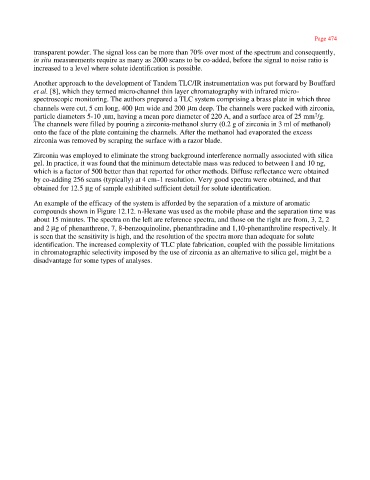Page 489 - Tandem Techniques
P. 489
Page 474
transparent powder. The signal loss can be more than 70% over most of the spectrum and consequently,
in situ measurements require as many as 2000 scans to be co-added, before the signal to noise ratio is
increased to a level where solute identification is possible.
Another approach to the development of Tandem TLC/IR instrumentation was put forward by Bouffard
et al. [8], which they termed micro-channel thin layer chromatography with infrared micro-
spectroscopic monitoring. The authors prepared a TLC system comprising a brass plate in which three
channels were cut, 5 cm long, 400 mm wide and 200 mm deep. The channels were packed with zirconia,
2
particle diameters 5-10 ,um, having a mean pore diameter of 220 A, and a surface area of 25 mm /g.
The channels were filled by pouring a zirconia-methanol slurry (0.2 g of zirconia in 3 ml of methanol)
onto the face of the plate containing the channels. After the methanol had evaporated the excess
zirconia was removed by scraping the surface with a razor blade.
Zirconia was employed to eliminate the strong background interference normally associated with silica
gel. In practice, it was found that the minimum detectable mass was reduced to between I and 10 ng,
which is a factor of 500 better than that reported for other methods. Diffuse reflectance were obtained
by co-adding 256 scans (typically) at 4 cm-1 resolution. Very good spectra were obtained, and that
obtained for 12.5 mg of sample exhibited sufficient detail for solute identification.
An example of the efficacy of the system is afforded by the separation of a mixture of aromatic
compounds shown in Figure 12.12. n-Hexane was used as the mobile phase and the separation time was
about 15 minutes. The spectra on the left are reference spectra, and those on the right are from, 3, 2, 2
and 2 mg of phenanthrene, 7, 8-benzoquinoline, phenanthradine and 1,10-phenanthroline respectively. It
is seen that the sensitivity is high, and the resolution of the spectra more than adequate for solute
identification. The increased complexity of TLC plate fabrication, coupled with the possible limitations
in chromatographic selectivity imposed by the use of zirconia as an alternative to silica gel, might be a
disadvantage for some types of analyses.

